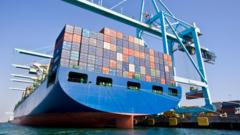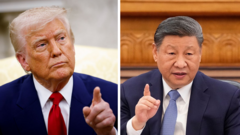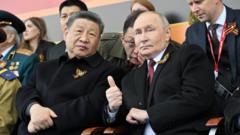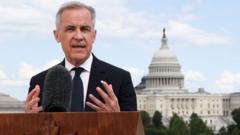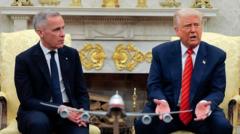Honda's decision adds pressure to Canada's new Prime Minister, Mark Carney, as the automotive industry grapples with tariff implications on production.
Tariffs Lead Honda to Shift SUV Production to U.S. Amid Trade Tensions

Tariffs Lead Honda to Shift SUV Production to U.S. Amid Trade Tensions
Ongoing trade conflict drives Honda to relocate Canadian operations to response to U.S. tariffs, impacting local employment and investment.
In a significant shift prompted by U.S. tariffs, Honda announced on Monday its decision to transfer production of the popular CR-V sport utility vehicle from Ontario, Canada, to a facility in the United States. This announcement comes alongside the postponement of an ambitious $11 billion electric vehicle and battery factory in Canada, which had initially garnered substantial government incentives and was expected to create around 1,000 jobs.
Honda's CEO, Toshiro Mibe, during a news conference in Japan, emphasized that the relocation aims to "optimize" production and mitigate the financial impact of the 25 percent tariff imposed by the U.S. on many Canadian automobiles and auto parts. The announcement contrasts sharply with a previous denial by Honda regarding the necessity to reduce its Canadian operations due to trade tariffs less than a month prior.
The automotive landscape in Canada is becoming increasingly challenging under these tariff conditions. Prime Minister Mark Carney, who recently took office after a resounding electoral victory, is facing significant hurdles as he takes on trade relations with the U.S., particularly navigating the complexities of the ongoing trade war. Carney had previously positioned himself as the best candidate to manage such challenges following his predecessor, Justin Trudeau.
The curtailment of Honda's expansion plan also highlights struggles within the electric vehicle market, which has not matured as expected. The planned investment had been hailed as one of the largest in Canadian automotive history and was part of a broader strategy to pivot Canada’s automotive sector toward electric vehicles.
The ramifications of Honda's production move include uncertain job impacts at its Ontario plant, which currently employs about 4,200 people and also manufactures Civic sedans and engines. The factory primarily exports the majority of its CR-Vs to the U.S., heightening concerns over local job security.
Honda now joins a growing list of automotive companies reevaluating their Canadian operations in light of U.S. tariffs. Stellantis has halted plans for a factory conversion in Toronto while General Motors has suspended production of an electric commercial van in Ontario. Ford's assembly plant in Oakville remains inactive after the company's shift away from electric vehicle production.
As Prime Minister Carney prepares to unveil his new cabinet, the strain on the Canadian automobile industry raises critical questions about the future of manufacturing in the wake of trade tensions with the neighboring United States.
Honda's CEO, Toshiro Mibe, during a news conference in Japan, emphasized that the relocation aims to "optimize" production and mitigate the financial impact of the 25 percent tariff imposed by the U.S. on many Canadian automobiles and auto parts. The announcement contrasts sharply with a previous denial by Honda regarding the necessity to reduce its Canadian operations due to trade tariffs less than a month prior.
The automotive landscape in Canada is becoming increasingly challenging under these tariff conditions. Prime Minister Mark Carney, who recently took office after a resounding electoral victory, is facing significant hurdles as he takes on trade relations with the U.S., particularly navigating the complexities of the ongoing trade war. Carney had previously positioned himself as the best candidate to manage such challenges following his predecessor, Justin Trudeau.
The curtailment of Honda's expansion plan also highlights struggles within the electric vehicle market, which has not matured as expected. The planned investment had been hailed as one of the largest in Canadian automotive history and was part of a broader strategy to pivot Canada’s automotive sector toward electric vehicles.
The ramifications of Honda's production move include uncertain job impacts at its Ontario plant, which currently employs about 4,200 people and also manufactures Civic sedans and engines. The factory primarily exports the majority of its CR-Vs to the U.S., heightening concerns over local job security.
Honda now joins a growing list of automotive companies reevaluating their Canadian operations in light of U.S. tariffs. Stellantis has halted plans for a factory conversion in Toronto while General Motors has suspended production of an electric commercial van in Ontario. Ford's assembly plant in Oakville remains inactive after the company's shift away from electric vehicle production.
As Prime Minister Carney prepares to unveil his new cabinet, the strain on the Canadian automobile industry raises critical questions about the future of manufacturing in the wake of trade tensions with the neighboring United States.

